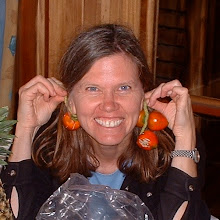I can spend hours at a time in a museum but on a recent trip to Chicago, we arrived at the Art Institute just 45 minutes before closing. The good news? If you get there within an hour of closing, it's only half price. Yet is it worth spending $9 for just a 45 minute visit? I thought so because I had my heart set on seeing a temporary exhibit of a weaving from Madagascar. It is woven of the silk from Golden Orb spiders.
The silk is probably the most beautiful naturally gold-colored fiber in the world. The weaving is made up of millions of strands of spider silk which the artisans extracted from the spiders before releasing them back to the wild. Each plain weave thread is made up of 96 strands of spider silk. The brocade threads that make up the design are 960 strands each. The designs are traditional from the area, but this is the only known textile of its kind. You can find a video about the making of textile here.
I next turned my attention to the rest of the new African gallery. This embroidered raffia weaving from the Kuba area of the Democratic Republic of the Congo is wonderfully abstract and was created in the early 20th century.
The adjacent gallery has objects from the Americas including some wonderful Peruvian pottery that was hard to photograph. My favorites included a "Bowl depicting a swarm of mice"with a highly organized group of rather cute mice. I also liked the whimsical "Vessel depicting the Assault of Bean Warriors." Who knew that beans wore helmets and carried weapons? Even though my picture didn't come out well enough to post here, I found that the Art Institute has a very nice site for searching their collection and you can see a photo of the bean warriors here. Now that I've discovered how to browse the Art Institute of Chicago's site I'm sure I will devote hours to virtual trips to the museum.
This bannerstone was found in Ohio and was created somewhere between 3,000 and 5,000 years ago. It's a wonderful miniature sculpture that was used to throw spears more efficiently.
Having such a short time really focused my museum visit. I visited just a few galleries and concentrated on a limited number of pieces. While I prefer longer visits, I highly enjoyed this one. Instead of Carpe diem, my motto for the day was "seize the minute."
The silk is probably the most beautiful naturally gold-colored fiber in the world. The weaving is made up of millions of strands of spider silk which the artisans extracted from the spiders before releasing them back to the wild. Each plain weave thread is made up of 96 strands of spider silk. The brocade threads that make up the design are 960 strands each. The designs are traditional from the area, but this is the only known textile of its kind. You can find a video about the making of textile here.
I next turned my attention to the rest of the new African gallery. This embroidered raffia weaving from the Kuba area of the Democratic Republic of the Congo is wonderfully abstract and was created in the early 20th century.
The adjacent gallery has objects from the Americas including some wonderful Peruvian pottery that was hard to photograph. My favorites included a "Bowl depicting a swarm of mice"with a highly organized group of rather cute mice. I also liked the whimsical "Vessel depicting the Assault of Bean Warriors." Who knew that beans wore helmets and carried weapons? Even though my picture didn't come out well enough to post here, I found that the Art Institute has a very nice site for searching their collection and you can see a photo of the bean warriors here. Now that I've discovered how to browse the Art Institute of Chicago's site I'm sure I will devote hours to virtual trips to the museum.
This bannerstone was found in Ohio and was created somewhere between 3,000 and 5,000 years ago. It's a wonderful miniature sculpture that was used to throw spears more efficiently.
Having such a short time really focused my museum visit. I visited just a few galleries and concentrated on a limited number of pieces. While I prefer longer visits, I highly enjoyed this one. Instead of Carpe diem, my motto for the day was "seize the minute."





















